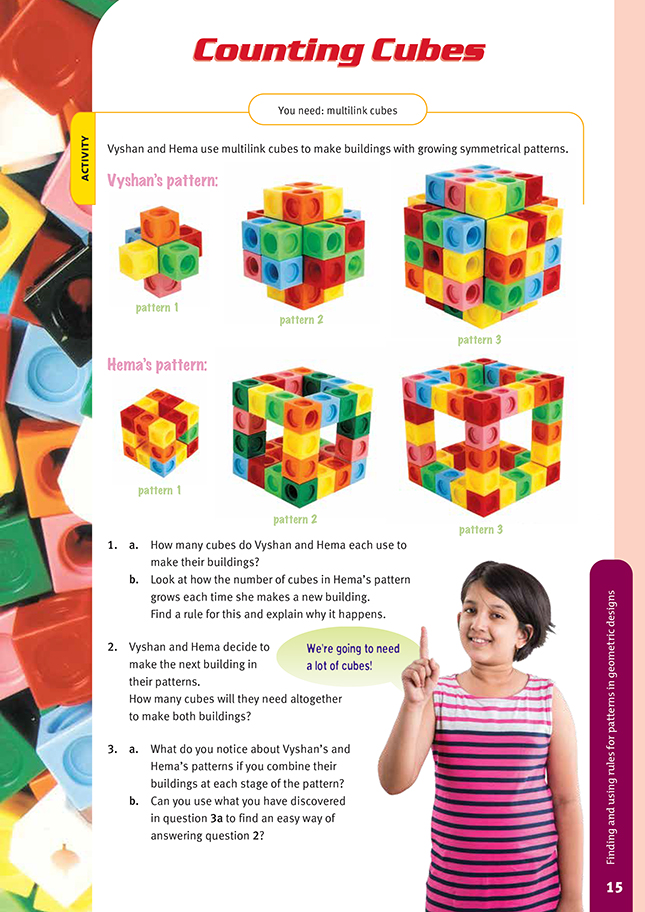This is a level 4 algebra strand activity from the Figure It Out series.
A PDF of the student activity is included.
Click on the image to enlarge it. Click again to close. Download PDF (151 KB)
write a rule to describe a pattern
use a rule to make predictions
FIO, Level 4+, Algebra, Book Four, Counting Cubes, page 15
multilink cubes (optional)
In this activity, students will need to use their spatial skills to visualise the growing patterns of cubes made by Vyshan and Hema. Each of Vyshan’s buildings has an inner solid core in the shape of a cube. The core cannot be seen because a layer of cubes covers each of its 6 faces. The following diagram shows the 6 layers for Vyshan’s pattern 2.
In the pattern, there are 2 x 2 x 2 = 8 cubes making up the central core. Each of the 6 faces of the core has a single layer of 2 x 2 = 4 cubes attached to it. So pattern 2 has 23 + 6 x 22 = 32 cubes altogether.
The following table shows the number of cubes making up each of Vyshan’s patterns and how the patterns in each column lead to algebraic rules.
There are various ways of looking at Hema’s pattern, but the simplest way to express a rule is explained in the Answers
The following table shows how this rule works:
Note that the number of cubes for any pattern is 12 more than in the previous pattern because 1 cube is added to each of the 12 edges of a pattern to make the next building in Hema’s pattern.
In answer to question 3a, students with a good spatial sense may notice that there is a simple connection between Vyshan’s and Hema’s buildings. For example, Vyshan’s first pattern fits into Hema’s first pattern to make a 3 x 3 x 3 = 27 solid cube. Their second patterns fit together to make a 4 x 4 x 4 = 64 solid cube, and so on. Geometrically, we say that the patterns complement one another.
The following table shows how this relationship can be used. Note that the number of cubes on each edge is 2 more than the pattern number. (So in pattern 1, there are 1 + 2 = 3 cubes on each edge.)
If we know any two of the column entries for a given pattern, we can easily calculate the third. For example, the number of cubes in each of Vyshan’s patterns can be found by subtracting the numbers of cubes in Hema’s corresponding pattern from the total number of cubes in the joined patterns.
Answers to Activity
- a. Vyshan’s pattern:
Pattern 1 has 7 cubes.
Pattern 2 has 32 cubes.
Pattern 3 has 81 cubes.
Hema’s pattern:
Pattern 1 has 20 cubes.
Pattern 2 has 32 cubes.
Pattern 3 has 44 cubes.
b. Each building has 12 edges surrounding the hollow space. The cubes are increasing by 12 because 1 cube is added to each of the 12 edges to make the next building. A possible rule is: the number of cubes in the previous model plus 12.
Each pattern has 8 corner cubes. The number of cubes that link each corner grows with each pattern and is the same number as the pattern number. So a rule for the number of cubes in each pattern can be expressed as “12 times the pattern number + 8”. 2.
- 216 cubes. (Hema will need 56 cubes, and Vyshan will need 160 cubes (64 + 96).)
- a. Vyshan’s first pattern fits into Hema’s first pattern to make a 3 by 3 by 3 solid cube, his second pattern fits into Hema’s second pattern to make a 4 by 4 by 4 solid cube, and so on.
b. Hema’s next building will have 6 cubes along each edge. Vyshan’s next building fits inside Hema’s building to make a solid cube, so they will need a total of 6 x 6 x 6 (or 63) = 216 cubes.
